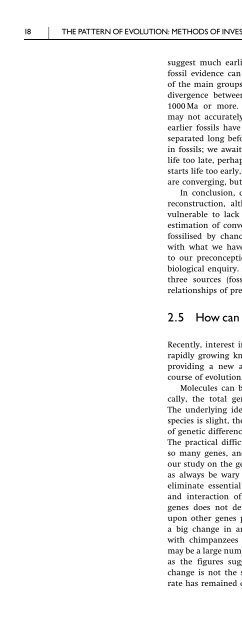An Introduction to the Invertebrates, Second Edition - tiera.ru
An Introduction to the Invertebrates, Second Edition - tiera.ru
An Introduction to the Invertebrates, Second Edition - tiera.ru
You also want an ePaper? Increase the reach of your titles
YUMPU automatically turns print PDFs into web optimized ePapers that Google loves.
18 THE PATTERN OF EVOLUTION: METHODS OF INVESTIGATIONsuggest much earlier dates for <strong>the</strong> establishment of animals thanfossil evidence can verify. A study of 18 genes placed <strong>the</strong> divisionof <strong>the</strong> main groups of animals as early as 670 Ma, with <strong>the</strong> earliestdivergence between <strong>the</strong> earliest animals and <strong>the</strong>se main groups1000 Ma or more. Is this discrepancy because molecular changemay not accurately measure <strong>the</strong> passage of time, or is it becauseearlier fossils have not been found? Evolutionary lines could haveseparated long before morphological differences became detectablein fossils; we await more evidence. At present fossil evidence startslife <strong>to</strong>o late, perhaps due <strong>to</strong> missing fossils, and molecular evidencestarts life <strong>to</strong>o early, perhaps due <strong>to</strong> statistical bias. The two estimatesare converging, but seem unlikely <strong>to</strong> meet firmly.In conclusion, clearly fossils must be included in phylogeneticreconst<strong>ru</strong>ction, although cladistic analysis of fossils is especiallyvulnerable <strong>to</strong> lack of information about characters and <strong>to</strong> underestimationof convergence. We do risk overemphasising charactersfossilised by chance but, as with any method, we have <strong>to</strong> workwith what we have got. We do risk interpreting fossils according<strong>to</strong> our preconceptions but, again, we can do that in any form ofbiological enquiry. At least we can now compare <strong>the</strong> evidence fromthree sources (fossils, morphology and molecules) <strong>to</strong> assess <strong>the</strong>relationships of present-day animals.2.5 How can we use molecules <strong>to</strong> trace phylogeny?Recently, interest in phylogeny has received a new impetus, as ourrapidly growing knowledge of genetics and molecular evolution isproviding a new approach, a new source of evidence about <strong>the</strong>course of evolution.Molecules can be used in different ways. For example, <strong>the</strong>oretically,<strong>the</strong> <strong>to</strong>tal genes of two different species can be compared.The underlying idea is that if <strong>the</strong> genetic difference between twospecies is slight, <strong>the</strong>y are liable <strong>to</strong> be closely related, and <strong>the</strong> degreeof genetic difference will indicate <strong>the</strong> closeness of that relationship.The practical difficulties are enormous because most animals haveso many genes, and <strong>the</strong>re are <strong>the</strong>oretical difficulties also. To baseour study on <strong>the</strong> genotype itself seems very attractive, but we mustas always be wary of reduction <strong>to</strong> <strong>the</strong> simplest units, as this willeliminate essential information that depends on <strong>the</strong> organisationand interaction of those units. The sheer presence of particulargenes does not define <strong>the</strong>ir effects: <strong>the</strong> action of genes dependsupon o<strong>the</strong>r genes present, and a small change in genes can makea big change in animals. That we share about 99% of our geneswith chimpanzees at once illustrates this point. Even though 1%may be a large number of genes, we are not as similar <strong>to</strong> chimpanzeesas <strong>the</strong> figures suggest. As will be explained, <strong>the</strong> rate of geneticchange is not <strong>the</strong> same as <strong>the</strong> rate of species change, and nei<strong>the</strong>rrate has remained constant during evolution.











